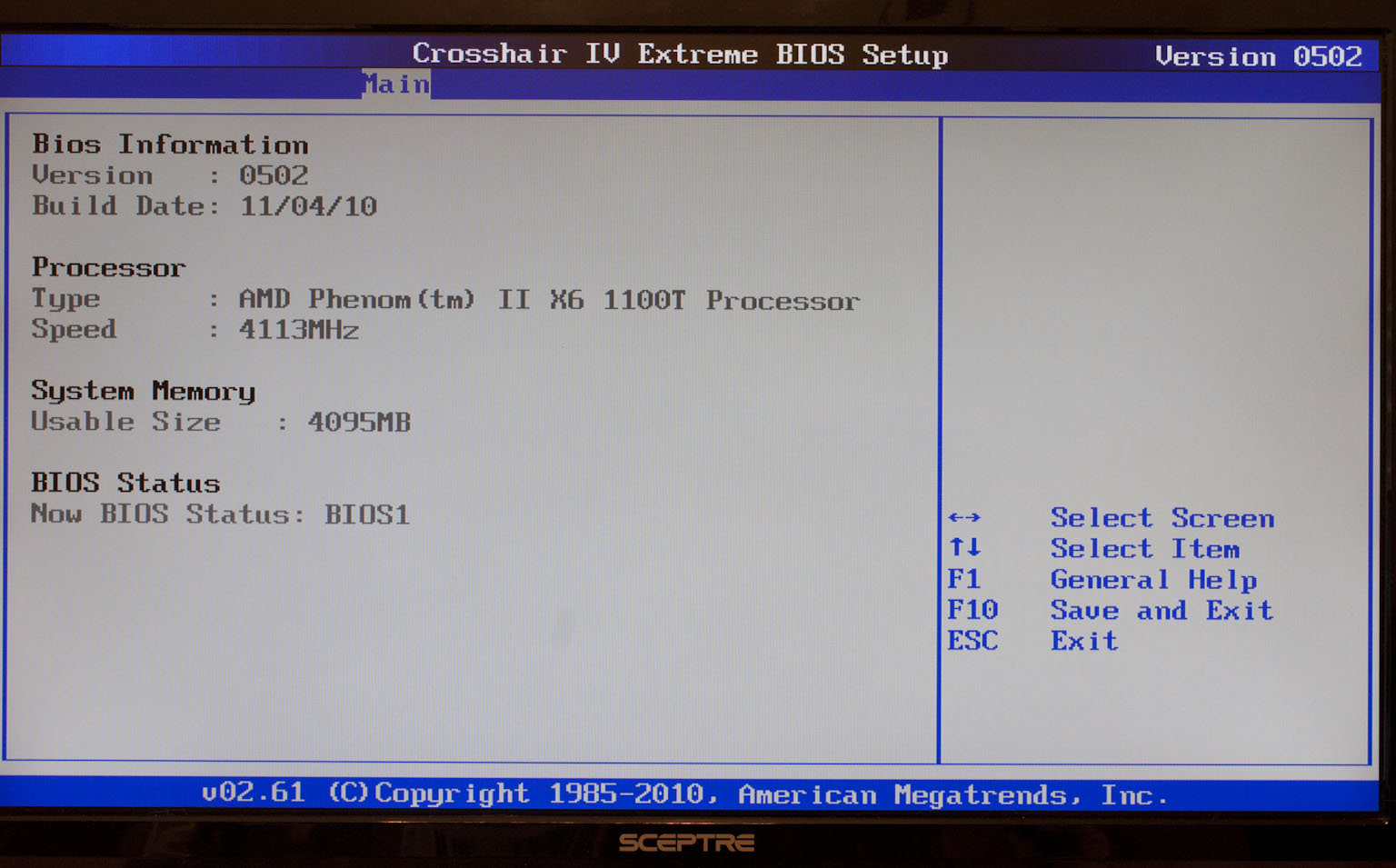BIOS -
BIOS is an acronym that stands for Basic Input/Output System. It is meant to control your product at a very low level. As of right now there are three regularly used BIOS formats (there are actually more than that but there are three common ones). These are the AMI (American Megatrends Incorporated), Award, and Phoenix. With all of the recent BIOS changes (for the P67 and Z68) we still find something comfortable about the old standard AMI BIOS layout. The Crosshair IV has one of these that has been modified by Asus to suit their needs. When you open up the BIOS you start off right in the thick of things on the Extreme Tweaker page.
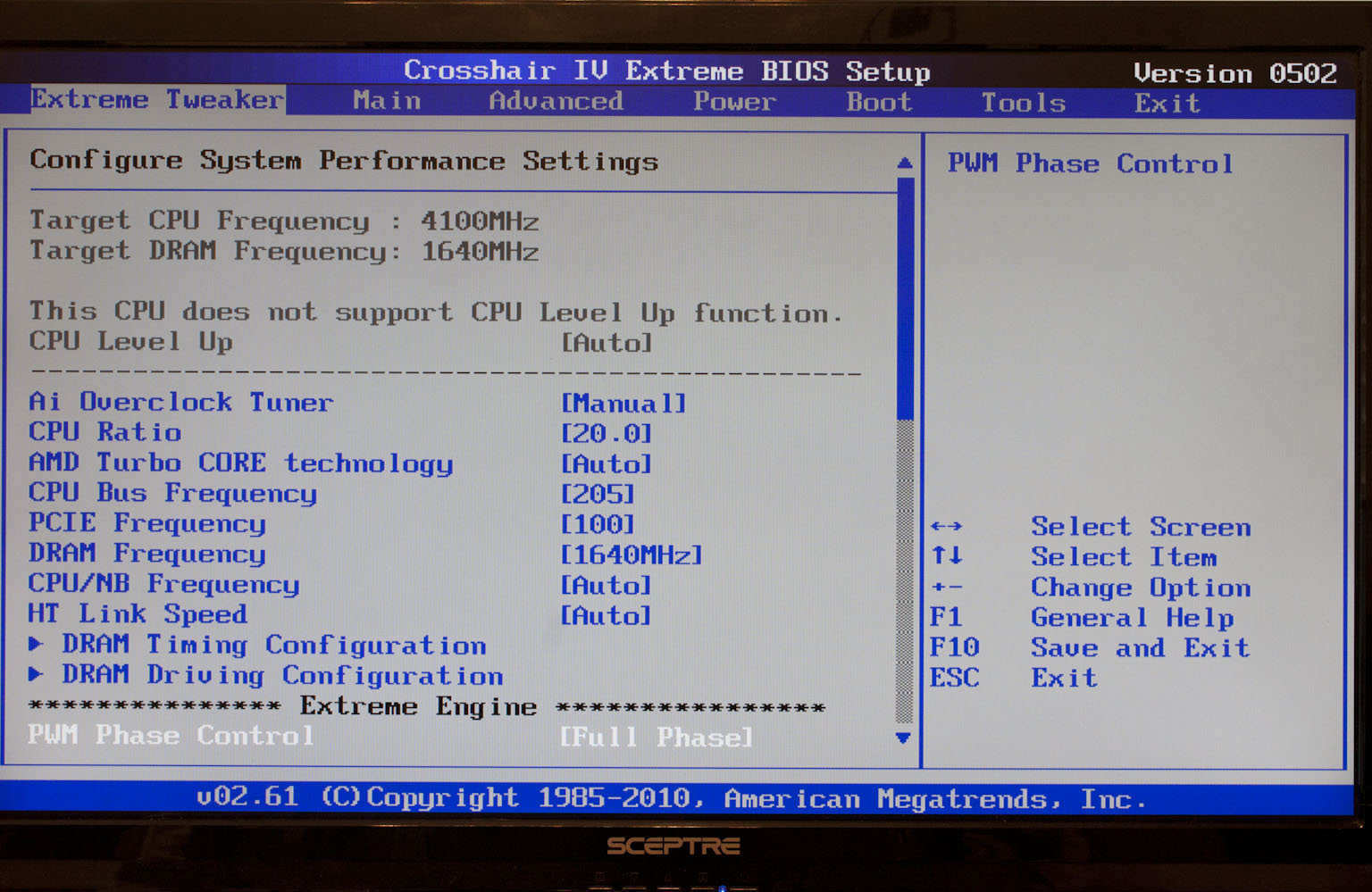 |
 |
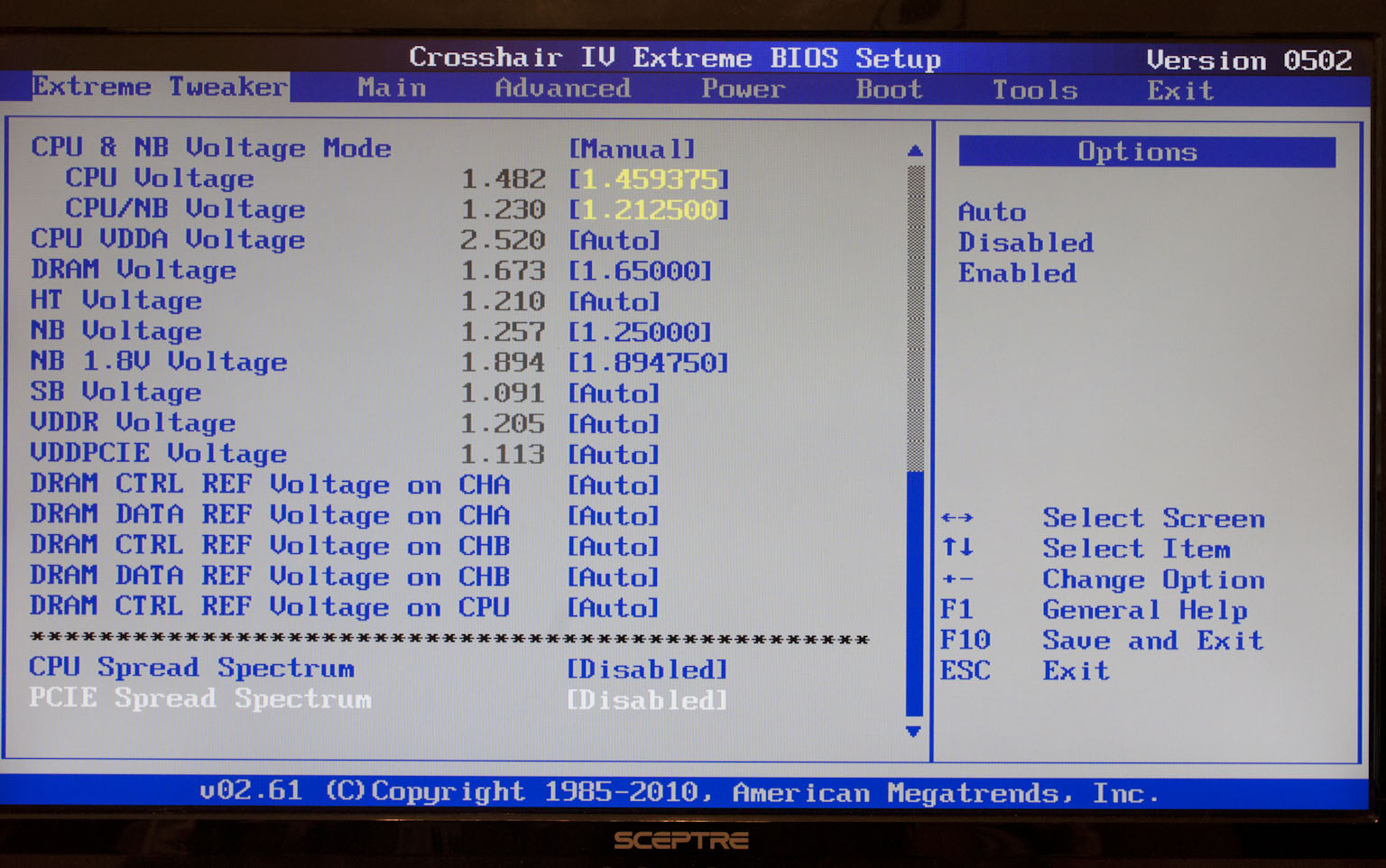 |
Asus has always likes to give their enthusiast customers the most control they can offer. This means that you have direct input for the majority of these settings. As with all of their ROG line you also have a good amount of control over the power regulation including being able to tweak the frequency that it operates at. This little adjustment can help to improve stability when you are pushing a lot of voltage through the board. The last two items on the board are one that I find interesting. Their intent is to help prevent crosstalk at high frequencies; however they more often than not cause stability issues even at stock speeds. Since this setting is in every BIOS regardless of manufacturer, we are not faulting Asus on this one.
 |
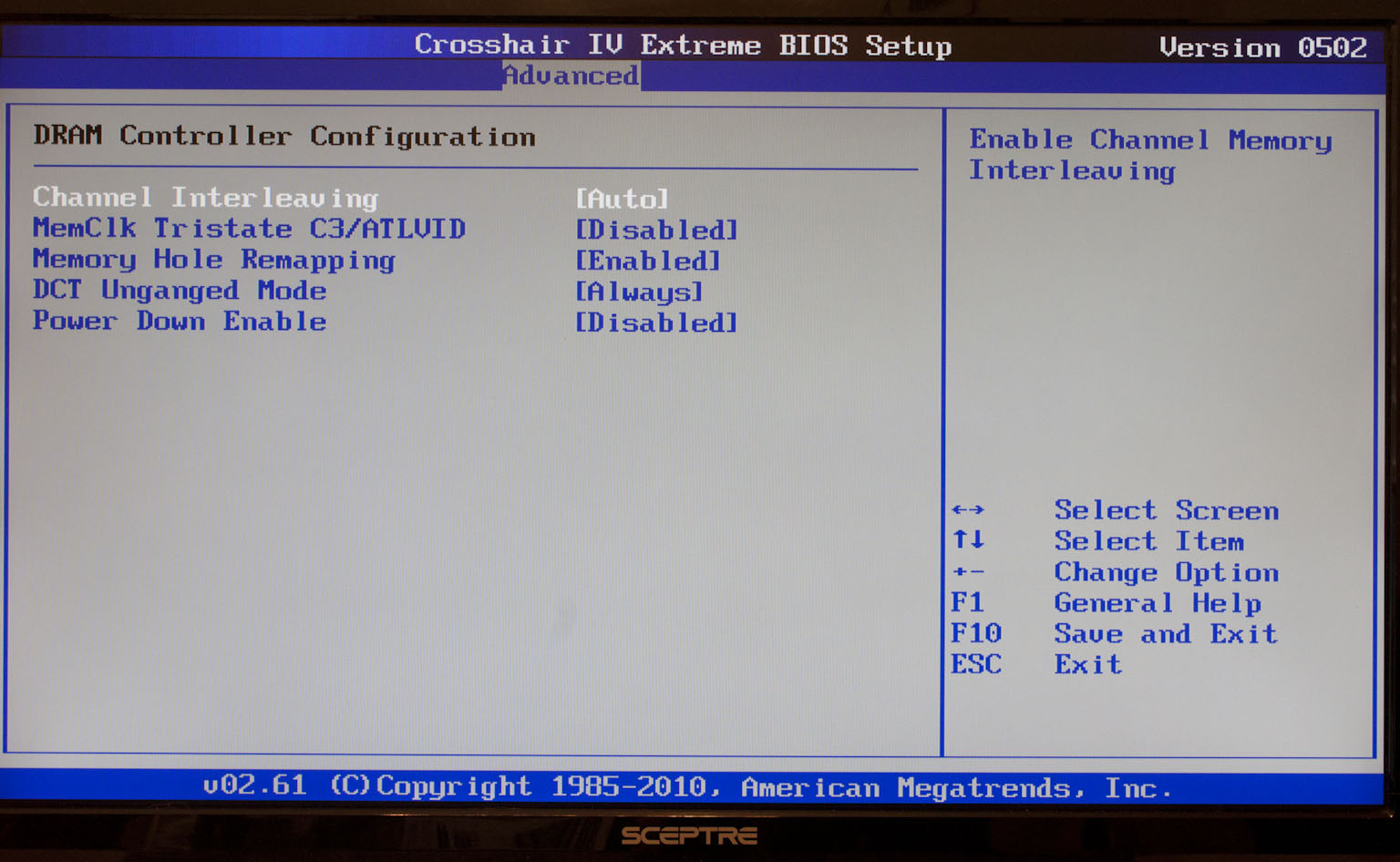 |
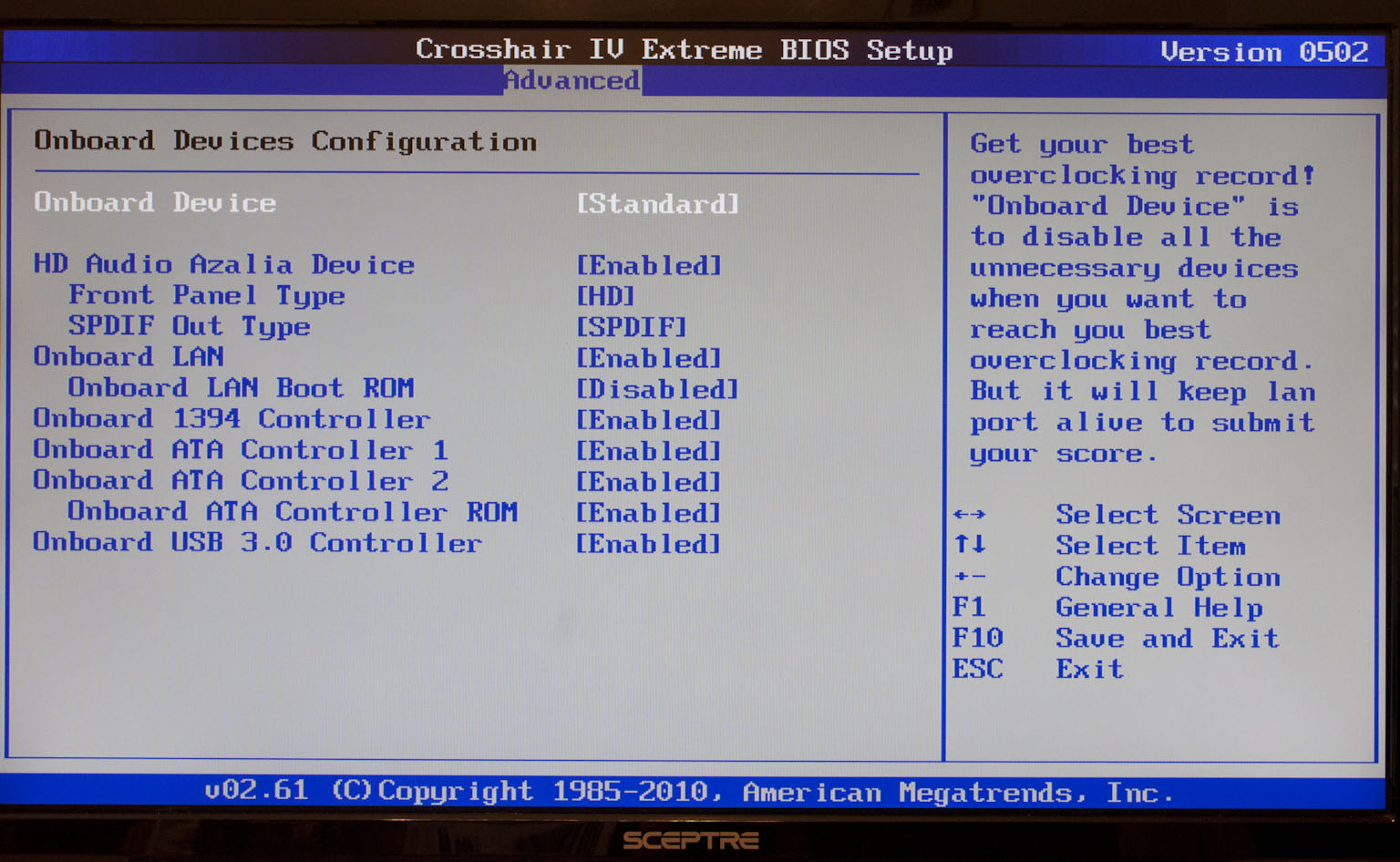 |
The next couple of stops on the BIOS trail are the Main and Advanced pages. The “Main” page is all information and in a way not of much use. The Advanced page handles some CPU functions including the Core Unlocker. You also get some advanced memory options to tinker around with. On the onboard devices page you have a rather fun option. You can turn off all peripheral devices with a single keystroke. This can certainly improve your overclocking if you do not have to worry about power draw and resources for these parts.
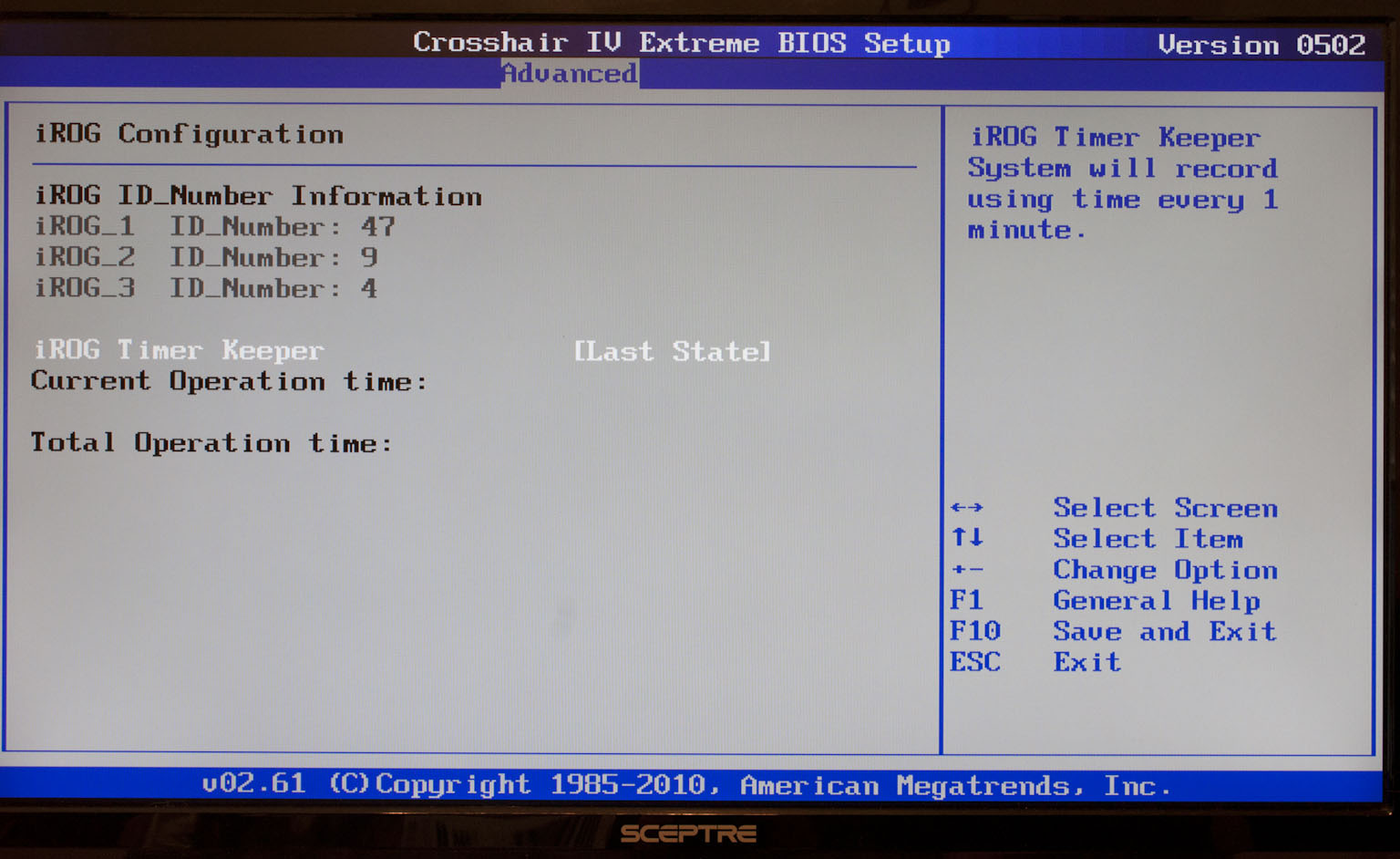 |
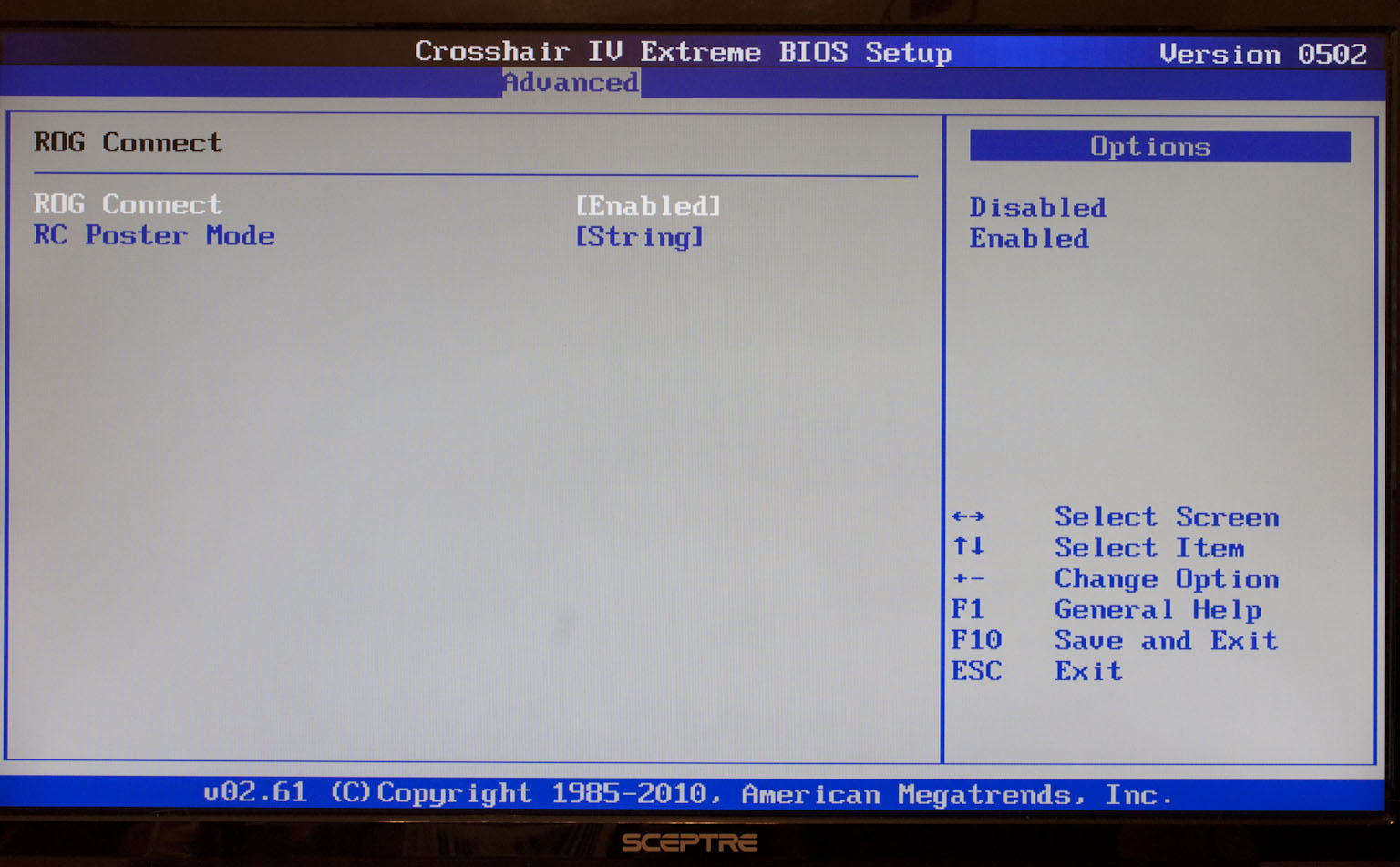 |
The last part of the Advanced page is the iROG connect options.
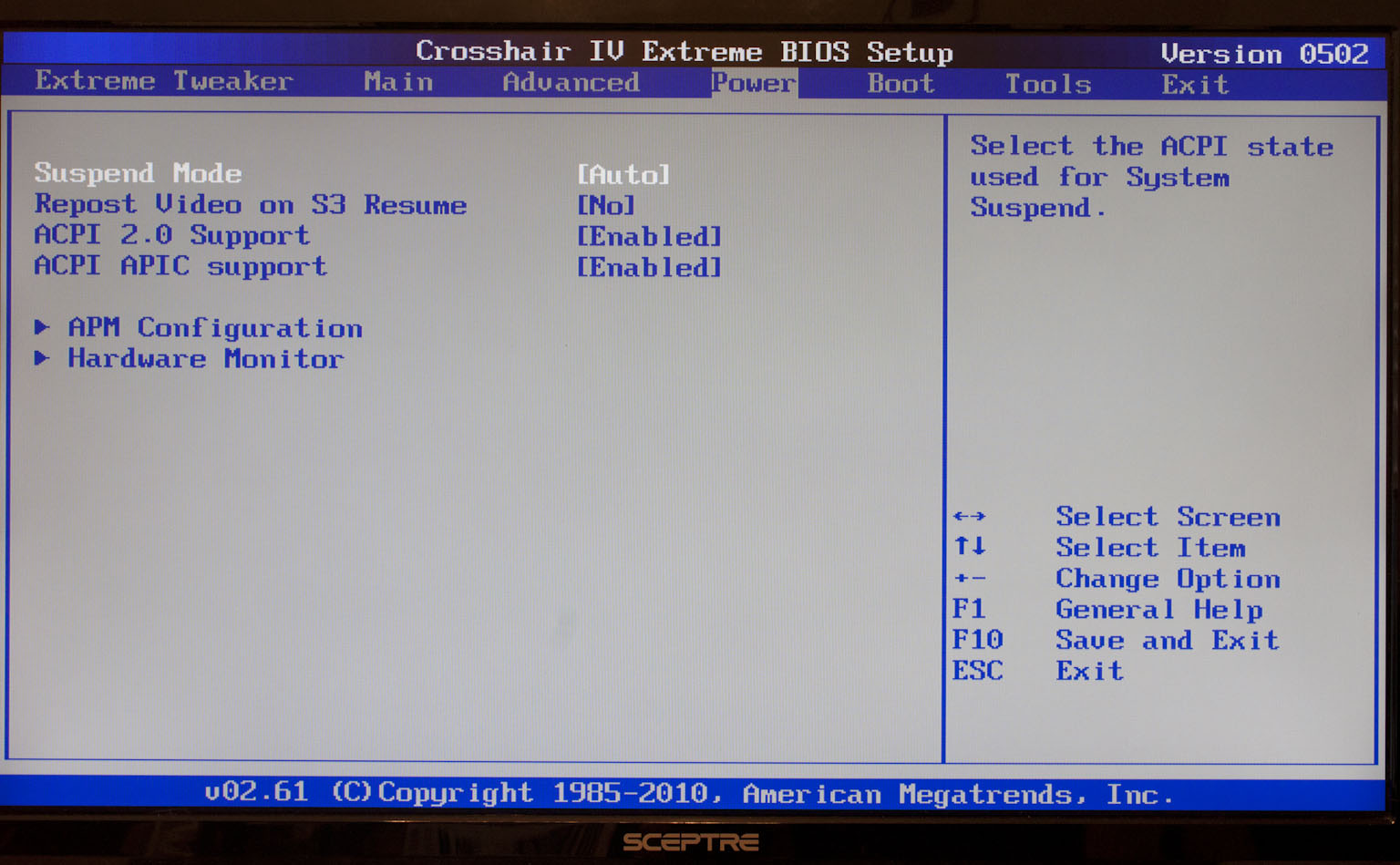 |
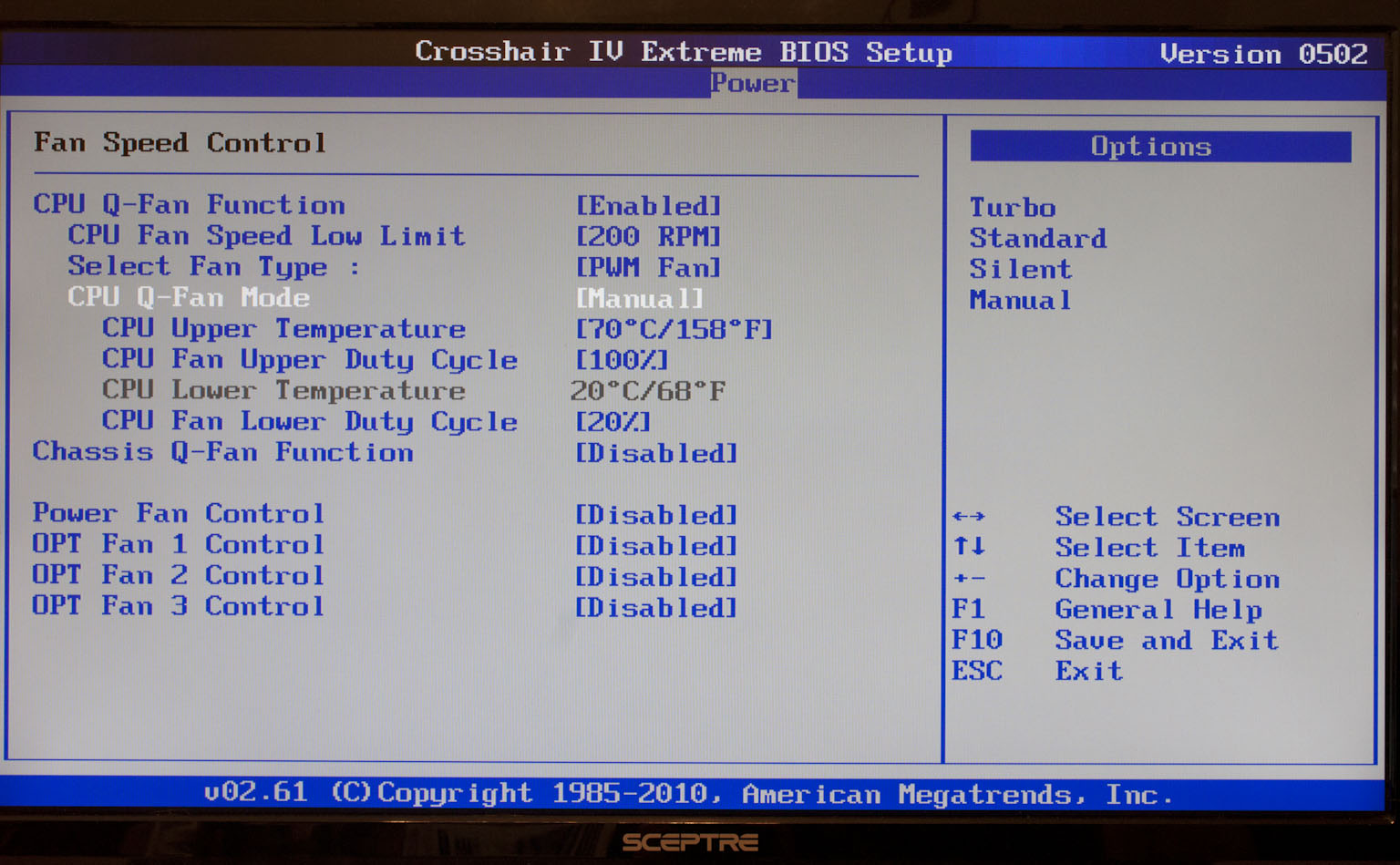 |
 |
The power pages are somewhat boring but they do have the Asus Q-Fan options. The Q-Fan options are very nice. I like to set them up to manual and give them a fairly decent temperature range to work with. This way if I am really pushing things (like gaming) I can let the fans go full out as I usually have headphones on anyway. On the very last page we will cover you get a few nice tools that are often overlooked.
Overclocking -
There was a time when AMD was the CPU of choice when it came to overclocking. However that seems to have passed for the most part. With the last few generation the max clock speeds that I have gotten have been less than stellar. I have tried multiple methods for getting a high clock, from just setting the multiplier to tweaking the bus to a combination of both. None of these have yielded more than about 500MHz over stock. I do not think this is a fault of the boards I have used but more an issue with the CPUs. It seems that the more cores that are thrown into an AMD CPU the harder it is to push them to higher clocks. This is supported by the failures I was getting at higher speeds (it was a core timing error).
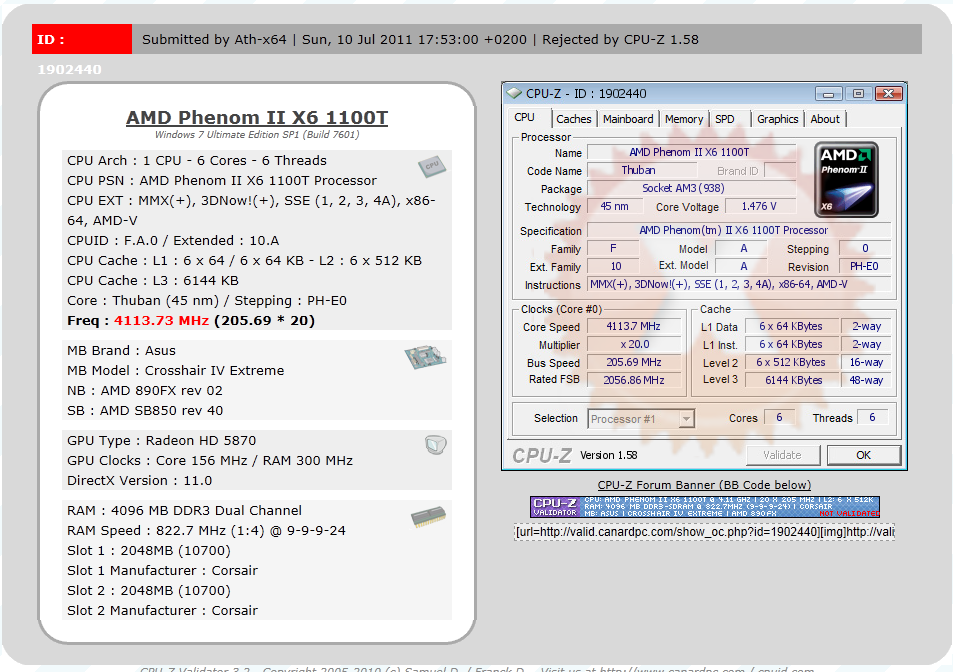
We are not sure why this OC was rejected but it was multiple times. The only possibility we have found is that this 1100T is an early CPU and shows up at times as an ES CPU. However it is what it is.
Of course overclocking is a picky subject. I can buy to identical CPUs from the store and they will not always perform the same way under stress. This is the same with motherboards, RAM and GPUs. So again it is important to keep in mind that our results represent a specific hardware configuration. Yours may be similar but will rarely be identical.
Overclocking Tools -
Asus primary overclocking tool is TurboV EVO. This software is part of the AI Suite II This suite has much more than just the TurboV EVO software but for right now we will just cover this one. I like the look of the TurboV software. It is clean and matches the theme of the ROG line up. At the upper levels the TurboV software loses a few things; you have no automatic tuning options. To get the clock you want you are going to have to work this one out manually.
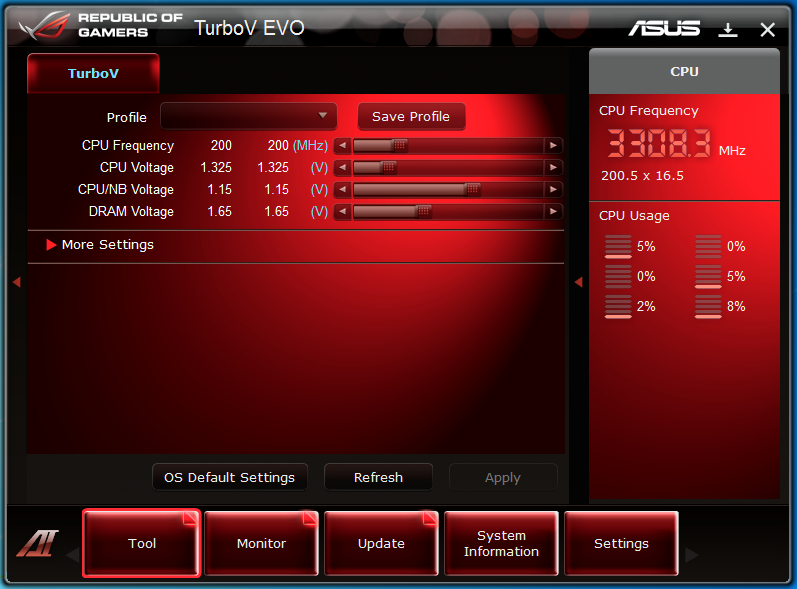 |
 |
There are more tools in here to help with your overclock. You also get access to the board fan headers and can setup fan profiles. The Probe II tab gives you access to and information on all of the sensors on the board. This is nice and also allows you to set thresholds for alarms. The Sensor recorder allows you to monitor the state of the board during testing that require full screen access, or when you might not have visibility on this window.
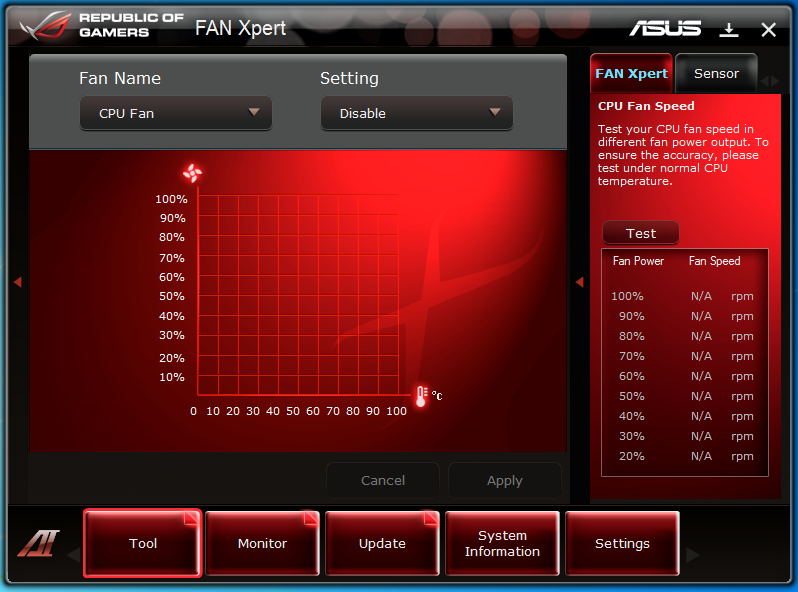 |
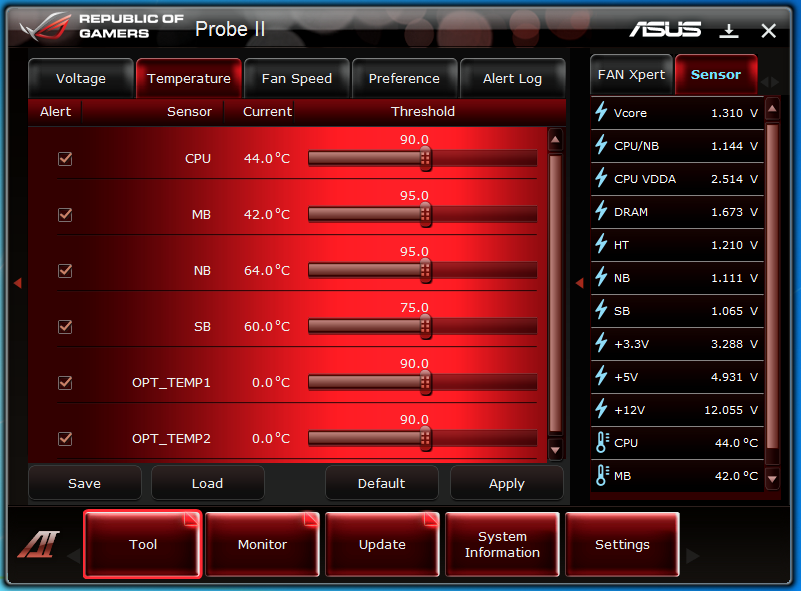 |
If you are wondering why we are not covering the ROG Connect in detail it is becasue it is not much different from what we saw here on the Rampage III Extreme
The Test System and Comments -
 Our test system is built on an open bench. This has two effects on testing. First it allows us to see everything and also to setup and disassemble the test rigs quickly. Second it means that we cannot gauge the potential air flow found in a normal case. The air is pretty stagnant; some may say this is a great neutral testing method and it can be. However, it does mean that the temperature reading taken off of the components are not accurate to what an average consumer would see. This means that your thermal performance will vary from what we see here.
Our test system is built on an open bench. This has two effects on testing. First it allows us to see everything and also to setup and disassemble the test rigs quickly. Second it means that we cannot gauge the potential air flow found in a normal case. The air is pretty stagnant; some may say this is a great neutral testing method and it can be. However, it does mean that the temperature reading taken off of the components are not accurate to what an average consumer would see. This means that your thermal performance will vary from what we see here.
 |
 |
 |
The build out of the Asus Crosshair IV was pretty easy. I had a couple of minor issues at first but these ended up being with some of the hardware I was using and not the board. The Windows 7 install went without issue and driver installation was a snap. Once we had the board updated with the latest patches and service packs we installed the utilities. The most interesting was the AI Suite II. We talked a little bit about this above in the overclocking section but there is more to it than that. Asus has pretty much set this up as the one stop tool of this board (and others). You can update your board drivers and BIOS, change the Boot logo, get detailed information about your system and even change the information that the AI Suite II displays.
Performance testing overview -
Our testing is a little different than most. We combine both synthetic and real-world applications to simulate the types of performance common to the individual products. For motherboards this means that we run roughly six synthetic tests and two real-world. We will be expanding the real-world testing in the near future. But there is more to performance than just the raw numbers. As there are multiple components and sub-components on a motherboard there each item can have a distinct impact on the way the product will perform once you get it in your system. It is important to note not only the actual results but what they mean to you as a potential consumer. We will try to give this information to you. But we do not just cover the performance aspects that are measurable. We also talk about the components that might not have a direct benchmark. These are items like Audio Quality, ease of use and installation.
Section 1 Subsystems -
Memory -
Memory performance is very important on a motherboard, especially when you have a CPU with multiple cores and threads. If you have slow memory your cores and threads can become starved for data to execute. To test memory performance we run both Sisoft’s SANDRA and AIDA64. These two combine to not only give us accurate numbers but to validate each other. For testing at stock speeds the memory is hard set to 1333MHz while overclocking testing is done at the highest stable speed for the voltage of 1.65v this is due to the different memory dividers for each CPU. As such, the memory speeds will vary greatly. This means that the overclocked numbers are a little misleading and while they can show a trend are really only included to show if a board has a problem with memory performance at high clockspeeds.

As with most boards these days the Crosshair IV is limited by the Internal Memory Controller on the CPU. In this case the AMD memory controller has some performance issues. Some of this is due to the way it handles memory and caching. The AMD based IMC takes a bigger hit from the high latency found in most DDR3. This has been an Achilles Heel for AMD ever since the AM2 CPU when they had to make the move to DDR2. There are ways to compensate for this to a degree though and AMD has been working on these to make up for the slower memory performance. 
Drive performance -
Drive performance is also one of the major subsystems that goes to make up the performance of a motherboard. For our testing we use Sandra and AIDA64 again. We only test with single drives for each type of controller present on the motherboard (unless it is a professional product where we will use RIAD 5 and/or 10). We have also begun using a Seagate PS-110 USB 3 external HDD for our USB 3.0 performance. As a side note, we include the overclocked numbers here to make sure (again) that you are not going to see a major drop in performance due to minor instabilities at high clock speeds.
 On the other side of the coin though AMD’s native SATA 3.0 controller is pretty fast. We are seeing excellent performance from both SATA 2.0 SSDs and SATA 3.0 HDDs. We are looking forward to seeing what we can get this to do when we get our SATA 3.0 SSDs in hand.
On the other side of the coin though AMD’s native SATA 3.0 controller is pretty fast. We are seeing excellent performance from both SATA 2.0 SSDs and SATA 3.0 HDDs. We are looking forward to seeing what we can get this to do when we get our SATA 3.0 SSDs in hand.

Power -
Power efficiency is another of those misnomers that we get caught up in. We hear about idle states and power gates. But what does that mean to you and I? On the surface having power management that reduces idle power sounds great and can be a benefit to someone that leaves their system on for long periods of time (and inactive) but how a system handles power under load and the delta between the two states is often more important than the idle power usage numbers. We use only P3 Kill A Watt instruments for measuring power.

The Asus Crosshair IV Extreme is not a terribly power efficient motherboard. Of course that is not unexpected considering the CPU has a 140 Watt TDP (Max) and the other pieces that we have in the board. Still, it does draw a little more power than we expected from an Asus board. Considering the fact that this is an enthusiast board and meant to be pushed I am fairly certain that will not put anyone off from buying it though.

Cooling (Board Level) -
Board level cooling is an important factor in product performance and longevity. Components like the chipset, VRM modules and even capacitors need to be kept relatively cool to prevent failure. As these parts are made of silicon, they have a thermal breakdown threshold; or melting point. At that temperature the actual transistors built into chip will begin to deform and break down. Granted, the threshold is often very high, but you still need to make sure that components stay away from this level of heat for longer product life.

Despite the beefy cooling on the Crosshair IV Extreme it has a hard time keeping up with the heat that can be generated by this board. A large part of this heat is the HydrLogix chip that is up by the power regulation, but the board gets a little hotter than we would like to be honest.

Audio -
Audio is highly subjective. What we find pleasing may sound “off” to you. That is always going to the problem with testing audio; results will vary too widely depending on the tastes of the listener. However, there are ways of measuring the audio output with an objective ear. There is also the issue of audio causing performance issues in gaming and video playback. The reason this is a potential source of concern is that all onboard audio CODECs (Compression/Decompression) are CPU controlled. This means that while the audio chip controls the audio levels and effects of the audio the actual work is done on the CPU. Usually this will not be a problem with today’s powerful CPUs. Even the lower and consumer level products can handle high-end audio these days. But again there is the chance that a bad design or software will hinder your system and performance. On the other side the limits of board space, cost, etc will also prevent the level of audio quality you can get from an add-in board. We test all audio parts with three media types, Movie (DVD), MP3 Music, and Gaming. These are pushed to our Tec On model 55 Tube Amp to see if we can detect any signal issues in the reproduction.
Board level audio is getting better and at the level that the Crosshair IV Extreme is at it should have good audio. Fortunately for you Asus has put a good audio CODEC on the Crosshair IV Extreme. We ran movies, games and MP3 audio through it and found it to be more than acceptable. It is true than an audiophile would not find it great, but if you are that picky you will want to get an add-in board anyway.
Networking -
This one is something that is a requirement anymore. If you have a computer, the chances are good (like 99%) that you are also connected to high-speed internet. With this you need a good and solid LAN chip to make sure that your data flows properly out and back.
Asus has put Intel Network chips on almost all of their boards now. This has improved their networking performance quite a bit. The Crosshair IV Extreme also has one of these handy little Intel LAN controllers. Because of this we saw great performance and better than average sustained transfer speeds when moving large files across our network.
Section II - Performance Tests, Synthetic -
In this section of testing we cover the synthetics. These are tests that run a scripted sequence of internal APIs or that use another installed application to perform a series of scripted events. They are great in that they can provide reproducible results across various platforms. On the down side, synthetic tests can be fooled with driver tweaks and optimizations. In some cases it is necessary to rename the .exe file to something generic to discover if this is the case. In any event when this is needed (when a test shows a drastic difference in performance over the renamed exe) we will note this and show both results for comparison.
PCMark Vantage -
PCMark Vantage is a suite of tests designed to test the power of your computer. It runs task that range from productivity to gaming (DX9 only). It is a great test to identify potential problem areas with general performance on a system. It can also show how well a single component can increase or decrease system-wide performance. We run both the x86 and x64 PCMark Suites for testing.

The Asus Crosshair IV did well in our PCMark Vantage testing. It ranked in the top three out of the boards we have tested. This is not too bad really although I can see where the memory speed has affected the performance results with this test.

PCMark7 -
PCMark7 is the latest general performance test from FutureMark. As each generation of this benchmark has evolved and developed we have watched them add more and more realistic tests to this suite. With this generation we find more media tests, (audio and video transcoding) moving of large files, multiple web page rendering, and much more (the even added DX10 gaming). We use the Overall Performance and Common Usage suites in our testing.

Although at this time we do not have anything else to compare these scores to directly, they are still fairly good. After we get a few more tests done in house we will be sure to return to PCMark7 and see how things stand.

3DMark 11 -
3DMark 11 is the other Futuremark test that we run on our motherboards. This test simulates the typical tasks that a GPU (and system) would have to perform to provide you with a good gaming experience. It is based on the DX9, DX10 and DX11 engines but can only be installed on Windows Vista or later. The suite of tests covers DX9, DX10, and of course DX11 rendering; it also covers AI computations and physics. That’s right I said Physics the latest version of 3DMark uses a Havok physics engine. This removes the advantage that nVidia had with 3DMark Vantage.
 Here we are more than a little disappointed. We had thought that the combination of the Crosshair IV and the Asus 5870 V2 graphics card would give us some excellent scores. However at stock speeds we find the Crosshair at the bottom of the list by 40 points. It is only when we overclocked the CPU that the score picked up at all and managed to come in right behind the MSI Big Bang Marshal.
Here we are more than a little disappointed. We had thought that the combination of the Crosshair IV and the Asus 5870 V2 graphics card would give us some excellent scores. However at stock speeds we find the Crosshair at the bottom of the list by 40 points. It is only when we overclocked the CPU that the score picked up at all and managed to come in right behind the MSI Big Bang Marshal.

HyperPi 0.99b -
HyperPi is a front end application that allows you to easily run multiple instances of the SuperPi application. SuperPi, for those that are not familiar with it, is an application that measures the time it takes to calculate the number Pi out to as many as 32 million places. This calculation is then checked and run multiple times (up to 24 for a 32M run). This test stresses the CPU, Memory and HDD as data is handed off between the three. If there is a weak link, HyperPi will show it. For our testing we run the 32M test on as many cores (and threads) as the CPU has available. The slowest CPU time is then recorded.

For an AMD board the Crosshair IV does well at HyperPI. At stock speeds it is at the top of the AMD group while it does not fare as well when we overclock the CPU.

Cinebench R11.5 -
Cinebench R11.5 is the 11th release of Maxon’s rendering test. This test is based off of the Cinema 4D engine, which is one of the industry standard tools for digital animation. It is a powerful product with many different modules that can be “plugged” into it to increase its effectiveness. With Cinebench you get to see how your computer would do using this application. There are two tests; one tests the CPU’s ability to render an image across multiple cores or threads. The other tests your systems ability to handle OpenGL based rendering.

Again we find the Asus Crosshair IV Extreme at the front of the AMD pack. We would have liked to see higher scores here, but they are still not too bad.

Section III - Performance Tests, Real-World -
Here we have two tests that are designed to put the performance of the motherboard and its subsystems to the test. Both require good CPU, Memory, HDD and even to a lesser extent audio and network performance. The two tests we chose were Lightwave 3D 9.6 and AutoGK 2.55. We will be adding at least one more real-world test to this battery in the near future, but for now these two cover quite a bit.
Lightwave 3D 9.6 x64 -
Lightwave is another industry standard application for 3D animation and rendering. It has a large tool base and the rendering engine is highly threaded (when using the right render model). This application is also capable of expanding to 4k resolutions as well as ray tracing for rending the light sources. For our testing we use frame 470 of the Pinball scene found in the LW 9 Content folder. This uses the newer perspective camera that is better suited to a multi-CPU/Core environment. This camera style also uses ray tracing and a much improved anti-aliasing method. Settings are shown below in the attached screen shot. Of course these are single frame renders and they are not a complete picture; for that you have to take into account the number of frames an average project would have. In a typical 30 second commercial you will have around 840 to 960 frames (at 28 – 32 FPS) this means that you have to multiply the time of a single frame by that number just to get a vague idea of how long that 30 seconds would take. This is because each frame will have a different render time based on complexity.
The Crosshair IV Extreme is back out in front of the AMD pack; unfortunately it cannot keep up with the Intel based products in Lightwave. This is very unfortunate as we have seen AMD do quite well on this test before.

The estimated project times serve to illustrate how importan those seconds can be

AutoGK 2.55 Transcoding -
AutoGK is a transcoding software that is really multiple parts combined to make an easy to use whole. It combines, items like FDD Show, Xvid encoder, Virtual Dub and others for use in converting one media format to another (usually Xvid AVI). It will not transcode copy protected DVDs or Bluray discs yet (you still need a decrypter for that). But it does an excellent job on everything else. For our testing we use a 2 hour movie that has been placed onto a standard definition DVD for playback; we then transcode this DVD to a 100% quality AVI with the original audio intact. This puts a strain on the CPU, Memory, HDD and the attached DVD ROM drive.

Our transcoding testing yielded some very different results. At stock speeds the Crosshair did not do too bad at all. However when we overclocked it we saw it drop back to the bottom of the pack. The reason for this can be linked to memory and caching again.

Section IV Performance – Gaming
Gaming as a test of motherboard performance is sort of a joke these days. The big player in the gaming arena is the GPU. Everyone but a few hardcore PR teams know this. However, it is important to run at least a few (one from each current DX version) to see if there are any issues with the combination of components on a motherboard. These are items like Audio lag, memory lag and of course problems with the PCIe lanes and signal traces. If there are issues in design, drivers or BIOS then you can have odd gaming performance. So without much more preamble let’s dive into the three games we currently use; Call of Duty Modern Warfare 2 for DX9 FarCry 2 for DX10 and Battlefield Bad Company 2 for DX11.
Call of Duty Modern Warfare 2 DX9 -
This is an excellent but short game that put you right into the action from the beginning and does not let up the pressure until the very end. The graphics are a little better; most notably the night and thermal imaging have been improved. The AI is still the typical COD “bar fight” style AI, with maybe a tad more finesse. All in all it is not a bad game to play and a decent one to use for testing. Our testing run starts at the bridge and ends after you clear the school in the first level of the game. Settings are shown below as are the performance numbers.
 |
 |

Although this is an older game (and the frame rates are sky high) we still like to see what is going on here as this is still a popular game. If you are a fan of Modern Warfare 2 and own an AMD CPU, this will gain you a small bump to your minimum frame rate. Of course we have to remind everyone that the numbers here are good across the board. We seriously doubt you would notice the difference between any of the boards in the group if you were looking at them side by side.

FarCry2 DX10 -
Although not one of my favorite games this tedious game does have some good graphics. The large sandbox style of the game lends to mission based play. The only problem is that the AI is rather low grade. Still the more CPU power the more the bad guys try to do. Over all the game was a little bit of a disappointment to play, but still not a bad DX10 representation. Our testing run starts right after you get your first mission to clean out the safe-house and ends after the hostage rescue. Settings and performance numbers are shown below.

For FarCry 2 the Crosshair IV Extreme appeared to have some issues. Although we are above our 32FPS mark with this board we were still surprised to see it below 40FPS minimum. Overclocking helped a little and brought us up to 42FPS. For this game it is important to remember that it was designed with the Intel Core CPUs in mind.

Battlefield Bad Company2 DX11 –
I have liked many of the Battlefield games. They usually tend to be fast paced and fun. With Battlefield Bad Company 2 you do get some of that, but there is something about the graphics and the movement that just does not sit right. The AI is a less sophisticated form of the bar fight AI, but it gets the job done. Still, the game is good for testing as it can put a strain on the components of the board. Out testing run is the entire first level, from beginning to end. Settings are shown below along with the raw numbers.


Now, when we test with a game that is built for the AMD GPU and we run it on an AMD platform (remember the whole “Dragon” idea?) we see the Asus Crosshair IV take off. It is out in front for this game even over some of the higher end Intel boards.

Gaming wrap-up -
The Asus Crosshair IV Extreme is a nice board for gaming. It offers quite a bit that you are not going to get on other platforms (at least not in the same way) You have multiple options for muli-GPU setups including mixing AMD and nVidia GPUs on the same board. You also have a great LAN controller for your online gaming and added to this is a solid audio CODEC to push out the sound from your games.
Value -
Value is another very subjective topic. What is expensive to some might be a deal to others. You can look at this topic in multiple ways. One is raw price and the other is what you get for the money. Each is accurate and both are correct ways to look at price/value. We tend to look at features, performance and real-property when we discuss value. However, we also take into account the raw cash cost of the item.
At $299 the Crosshair IV Extreme is an expensive board. In this price range you are going to expect a ton of performance and have a right to get it. On the one hand the Crosshair IV has the right stuff to equal this price in terms of sheer features and components. The problem that we have is that it falls a little short on the performance side of things when we compare this across both houses (Intel and AMD). If you compare AMD to AMD then the Asus Crosshair IV Extreme is a great value and does have the performance to match up to that price. You can also consider that the 1100T costs significantly less than the Intel CPU (2600k) we used which can offset the cost of the Crosshair.
Conclusion -
The Asus Crosshair IV Extreme is a bold product. Although not the first to market with a HydraLogix setup; Asus did take the time to really plan out what they wanted to offer. In the end we feel that they have done what they set out to. You are getting an AMD motherboard that stand out in front of most of the other boards based on the same chipset. Asus has also given you great flexibility with the Crosshair for tweaking and overclocking. Although we have not had much success in pushing any of the Phenom II X4 or x6 CPUs we have to high clock speeds the Asus Crosshair IV was able to help us get to our highest to date. If you own an AMD CPU then we can recommend the Crosshair IV as an upgrade for almost any 8xx series motherboard out there.
You can discuss this in our forum


